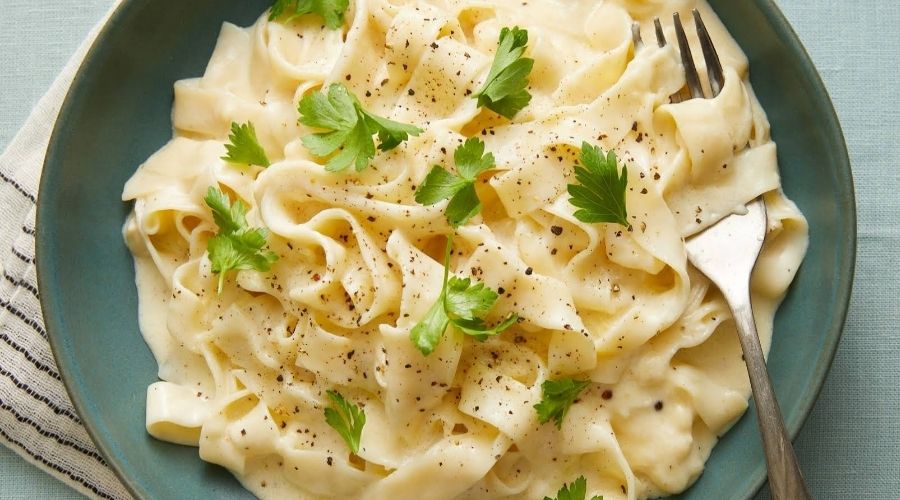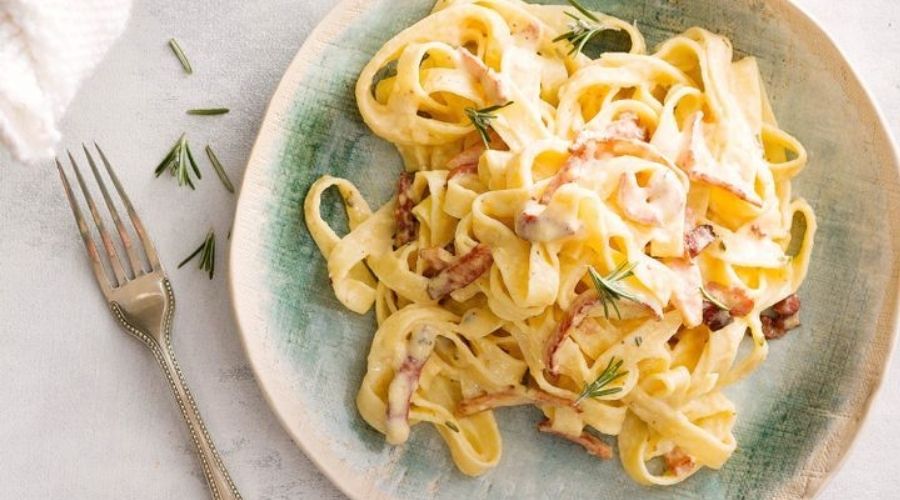Cooked fettuccine is a delightful staple in many kitchens, known for its versatility and satisfying texture.
Whether you’ve prepared a large batch for a family dinner or have leftovers from a restaurant, knowing how to store cooked fettuccine properly is essential to maintain its quality and flavor.
Improper storage can lead to spoilage, loss of texture, and even foodborne illnesses.
In this article, we’ll guide you through the best practices for storing cooked fettuccine, including refrigeration, freezing techniques, and tips for reheating.
With these simple guidelines, you can enjoy your favorite pasta dishes safely and deliciously, time and time again.
Why Storing Cooked Fettuccine Properly Matters
Storing cooked fettuccine properly is crucial for maintaining its flavor, texture, and overall quality.
As a popular pasta choice, fettuccine can easily become mushy or dry if not stored correctly.
Improper storage can lead to spoilage, resulting in unpleasant odors and taste, making your meal unappetizing.
Additionally, cooked fettuccine, like other perishable foods, is prone to bacterial growth if left at room temperature for too long.
By using airtight containers and refrigeration techniques, you can extend the pasta’s shelf life, ensuring it remains al dente and delicious for future meals.
Proper storage not only enhances your dining experience but also promotes food safety, allowing you to enjoy your favorite pasta dishes without the worry of foodborne illnesses.
How to Store Cooked Fettuccine: A Complete Guide

Storing cooked fettuccine properly ensures that you can enjoy its delightful texture and flavor even after it’s been prepared.
Here’s a comprehensive guide to help you keep your cooked fettuccine fresh and safe for later use.
1. Cool the Fettuccine
Before storing, allow the cooked fettuccine to cool to room temperature. This step usually takes about 15-30 minutes.
Cooling helps prevent condensation in the storage container, which can lead to a mushy texture.
2. Use the Right Storage Containers
Choose airtight containers for storing cooked fettuccine. Glass or BPA-free plastic containers work well, as they help keep out air and moisture. Ensure the containers are clean and dry before adding the pasta.
3. Portion Control
If you’ve made a large batch, consider dividing the fettuccine into smaller portions. This makes it easier to reheat only what you need, minimizing waste and preserving the quality of the remaining pasta.
4. Refrigeration for Short-Term Storage
For short-term storage, place the cooked fettuccine in the refrigerator. Properly stored, it can last for about 3-5 days.
Make sure the container is sealed tightly to maintain freshness and prevent odors from other foods.
5. Freezing for Long-Term Storage
If you want to store cooked fettuccine for a longer period, freezing is a great option.
Place the pasta in freezer-safe bags or containers, removing as much air as possible before sealing. Cooked fettuccine can be frozen for up to 2-3 months.
6. Labeling
Label your containers or bags with the date of storage. This helps you keep track of how long the fettuccine has been stored and ensures you use it within the recommended time frame.
7. Thawing Frozen Fettuccine
When you’re ready to use frozen fettuccine, thaw it in the refrigerator overnight. If you need it quickly, you can use the microwave’s defrost setting. Avoid thawing at room temperature to reduce the risk of bacterial growth.
8. Reheating Cooked Fettuccine
To reheat, you can use the microwave, stovetop, or oven. Add a splash of water or broth to keep the pasta moist, and heat until it reaches an internal temperature of 165°F (74°C). Stir occasionally to ensure even heating.
9. Check for Spoilage
Before consuming stored fettuccine, inspect it for any signs of spoilage. Look for off odors, changes in texture, or any visible mold. If you notice any of these signs, it’s best to discard the pasta.
By following these guidelines, you can effectively store cooked fettuccine, ensuring it remains delicious and safe to eat for your meals. Enjoy this versatile pasta with confidence!
What to Look for While Storing Cooked Fettuccine

When storing cooked fettuccine, it’s essential to pay attention to specific factors to ensure its quality, flavor, and safety.
Here are key points to consider:
1. Cooling Time
Allow the cooked fettuccine to cool before storage. Look for a cooling period of about 15-30 minutes.
This step is crucial to prevent condensation inside the storage container, which can lead to a soggy texture.
2. Quality of Storage Containers
Choose high-quality airtight containers designed for food storage. Look for options made of glass or BPA-free plastic. Ensure the containers are clean and dry to avoid contamination.
3. Sealing Techniques
When using containers, make sure they are sealed tightly. If using resealable bags, remove as much air as possible before sealing.
Proper sealing helps prevent air exposure and maintains the fettuccine’s texture.
4. Refrigeration vs. Freezing
Decide whether you’ll refrigerate or freeze the cooked fettuccine based on when you plan to consume it.
Look for storage time guidelines: cooked fettuccine can last 3-5 days in the refrigerator and up to 2-3 months in the freezer.
5. Portion Control
Consider portioning the cooked fettuccine into smaller servings for easier storage and reheating.
This also helps maintain freshness by reducing the amount of time each portion is exposed to air.
6. Signs of Spoilage
Before consuming stored fettuccine, inspect it for any signs of spoilage. Look for off odors, discoloration, or unusual textures.
If you notice any of these signs, it’s best to discard the pasta to ensure safety.
7. Storage Duration Awareness
Be mindful of how long your cooked fettuccine has been stored. Keeping track of recommended storage times will help you avoid eating spoiled food.
By keeping these factors in mind, you can effectively store cooked fettuccine, ensuring it remains fresh, flavorful, and safe to enjoy in your favorite dishes.
How to Choose the Right Accessories for Storing Cooked Fettuccine

Selecting the right accessories for storing cooked fettuccine is essential for maintaining its quality and freshness.
Here are some tips to help you choose the best storage options:
1. Airtight Containers
Invest in high-quality airtight containers to store your cooked fettuccine. Look for containers made of glass or BPA-free plastic with secure lids.
Airtight containers help prevent air and moisture from entering, keeping your pasta fresh and flavorful.
2. Freezer-Safe Bags
For long-term storage, consider using heavy-duty freezer-safe bags. Look for bags designed specifically for freezing to prevent freezer burn.
These bags allow you to remove excess air, preserving the texture and taste of the fettuccine.
3. Portion Control Tools
If you typically make large batches of cooked fettuccine, consider using portion control tools like silicone molds or smaller containers.
This allows you to separate servings for easy reheating and helps maintain freshness by limiting exposure to air.
4. Parchment or Wax Paper
When stacking cooked fettuccine in layers, consider using parchment or wax paper between layers to prevent sticking.
Ensure the paper is food-safe and will not impart any flavors to the pasta.
5. Labels and Markers
Using waterproof labels or a permanent marker to label your containers is a good practice. Look for options that are easy to read and resistant to smudging.
Clearly marking the date of storage helps you keep track of freshness and usage.
6. Cooling Racks
A cooling rack can be useful for allowing cooked fettuccine to cool properly before storage.
Look for a sturdy rack that promotes airflow around the pasta, helping to prevent condensation that can affect texture.
7. Reheating Containers
Consider your reheating method when choosing storage accessories. Look for containers that are oven-safe if you plan to reheat in the oven, or ensure they are microwave-safe if using a microwave.
By carefully selecting the right accessories for storing cooked fettuccine, you can ensure that it remains fresh, delicious, and safe to eat, enhancing your meal prep and dining experience.
How to Tell If Cooked Fettuccine Is Bad After Storing
Determining whether stored cooked fettuccine is still safe to eat is important for both food safety and taste.
Here are key indicators to help you identify if your fettuccine has gone bad:
1. Off Odors
One of the most noticeable signs of spoilage is an unpleasant smell. Fresh cooked fettuccine should have a mild, nutty aroma.
If you detect any sour, rancid, or strong odors, it’s a clear indication that the pasta has spoiled and should be discarded.
2. Texture Changes
Inspect the texture of the fettuccine. If it feels slimy, excessively mushy, or sticky, it may have gone bad.
Properly stored fettuccine should maintain a firm, chewy texture. Any unusual changes are a sign of spoilage.
3. Discoloration
Look for any abnormal discoloration. Fresh cooked fettuccine typically has a consistent pale yellow or light brown color.
If you notice dark spots, excessive dullness, or unusual hues, it may indicate spoilage.
4. Visible Mold
Any signs of mold are a definitive indication that the fettuccine is no longer safe to eat.
Mold can appear as green, white, or fuzzy spots. If you see any mold, it’s best to discard the entire batch to avoid health risks.
5. Extended Storage Time
Be mindful of how long the cooked fettuccine has been stored. Typically, it can last in the refrigerator for about 3-5 days.
If it has been stored beyond this timeframe, it’s safest to discard it, even if it appears fine.
6. Unusual Taste
If the fettuccine looks and smells normal but you’re still unsure, take a small taste. If it has an off, sour, or unusual flavor, it’s best to discard it to avoid any risk of foodborne illness.
By keeping an eye out for these signs, you can ensure that you enjoy only safe and delicious cooked fettuccine, minimizing the risk of foodborne illness and enhancing your overall dining experience.
1. How long can I store cooked fettuccine in the refrigerator?
Cooked fettuccine can be stored in the refrigerator for about 3-5 days. Make sure to keep it in an airtight container to maintain its freshness.
2. Can I freeze cooked fettuccine?
Yes, you can freeze cooked fettuccine. It can last for up to 2-3 months in the freezer when stored in freezer-safe bags or airtight containers.
3. Should I let cooked fettuccine cool before storing it?
Yes, it’s important to allow cooked fettuccine to cool to room temperature for about 15-30 minutes before storing. This helps prevent condensation inside the container.
4. What type of container is best for storing cooked fettuccine?
Airtight containers made of glass or BPA-free plastic are ideal for storing cooked fettuccine. These options help keep out air and moisture, preserving the pasta’s quality.
5. How can I tell if stored cooked fettuccine has gone bad?
Check for off odors, changes in texture (such as sliminess), discoloration, or visible mold. If you notice any of these signs, it’s best to discard the pasta.
6. Is it safe to reheat cooked fettuccine multiple times?
While it’s generally safe to reheat cooked fettuccine more than once, doing so can affect its quality. Always ensure it is heated to an internal temperature of 165°F (74°C) before consuming.
7. Can I store cooked fettuccine at room temperature?
It is not recommended to store cooked fettuccine at room temperature for more than 2 hours, as this can promote bacterial growth. Always refrigerate or freeze it promptly.
Conclusion
In conclusion, mastering the art of storing cooked fettuccine is crucial for anyone who enjoys this delicious pasta.
By following the right techniques—cooling it properly, using airtight containers, and being mindful of storage times—you can preserve its taste and texture for several days or even months.
Whether you’re preparing meals for the week or simply trying to minimize food waste, these storage tips will ensure that your fettuccine remains fresh and enjoyable.
With a little care and attention, you can savor your favorite fettuccine dishes anytime, knowing that they are safe to eat and full of flavor.
References
- https://www.bhg.com/recipes/how-to/food-storage-safety/storing-cooked-pasta/
- https://www.thespruceeats.com/how-to-store-leftover-cooked-pasta-482405
- https://www.quora.com/How-do-you-store-cooked-pasta-without-losing-the-bite
- https://www.reddit.com/r/recipes/comments/a0tymq/best_way_to_keep_leftover_pasta/
- https://www.wikihow.com/Store-Leftover-Pasta
- https://perfetto.com.sa/en/article/How-to-Store-Leftover-Pasta


